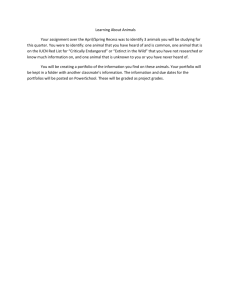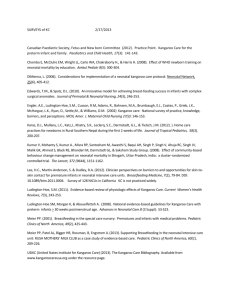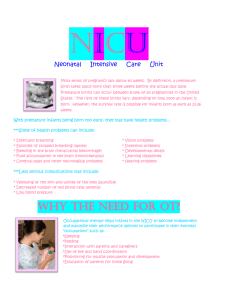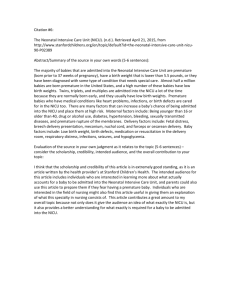File - Professional Portfolio
advertisement
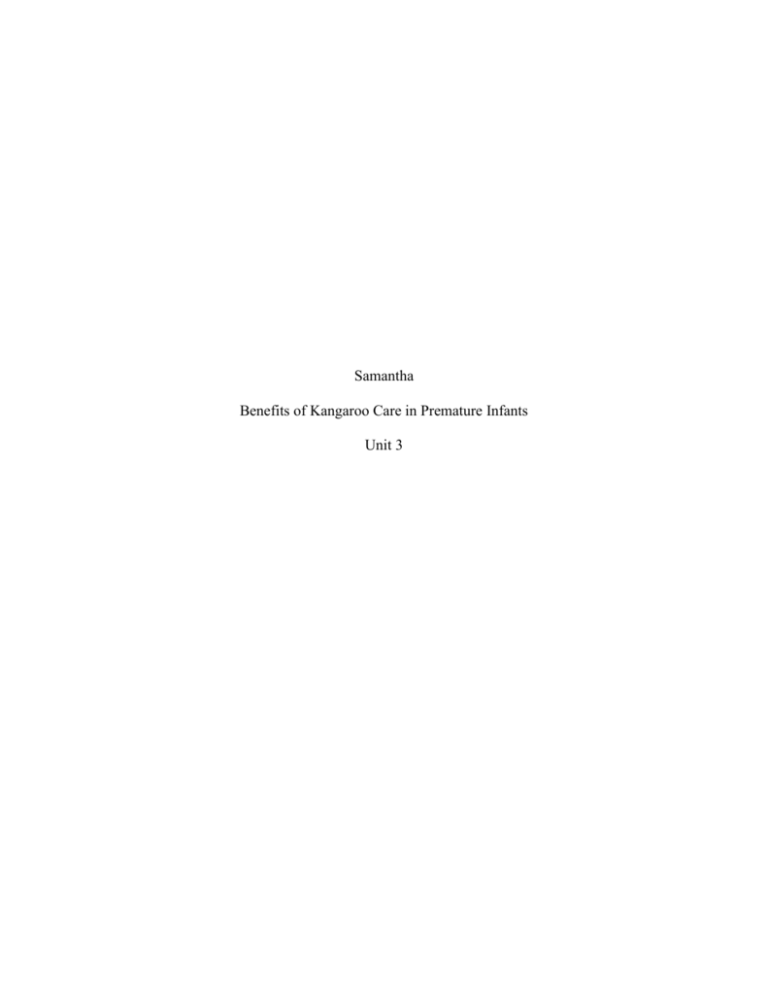
Samantha Benefits of Kangaroo Care in Premature Infants Unit 3 Abstract Kangaroo Care is the simple act of holding an infant “skin to skin.” In medical terms, and specifically regarding premature babies, its effects are pronounced and proven beneficial for both babies and parents. Physically, behaviorally and emotionally, kangaroo care has significantly improved and advanced the lives of countless premature infants throughout the world. The natural act of placing a pre-term infant on its mother’s chest has resulted in study after study of positive outcomes. Though many Neonatal Intensive Care Units (NICUs) support kangaroo care, some hospitals do not routinely utilize it and/or are undertrained in its use. Expanding and standardizing the provision of kangaroo care should be undertaken by neonatologists and medical facilities should incorporate the necessary equipment and training to make kangaroo care a standard in every hospital NICU. Introduction A premature baby is one that is born before 37 weeks of pregnancy. Often times, these tiny babies enter the world with moderate to severe health issues. Most spend time in a unit of the hospital known as the NICU, or neonatal intensive care unit. Health issues common to “preemies” include apnea, jaundice, anemia, infections and respiratory distress syndrome. The NICU is a uniquely specialized unit that provides incredible care and support to families going through a health crisis with their newborn.i Preterm birth is a very serious situation and is the largest direct cause of neonatal mortality. It accounts for almost 27% of the neonatal deaths every year.ii Parents and families of preemies will oftentimes spend days, weeks and even month in the NICU, making it difficult to bond with the newborn and making it harder to feel a connection with the child while they are living in the hospital. Kangaroo care (KC) is the practice of using skin-to-skin contact between newborn babies and their mothers shortly after birth. The technique began in 1978 with a Columbian doctor named Edgar Rey.iii Rey worked at a hospital that was overcrowded and low on incubators. Out of necessity, he suggested using the mother’s own body heat to properly regulate the baby’s temperature. The results were astonishing to the caregivers as the infants did very well despite the lack of technology. The technique has flourished and become popular throughout the world, especially in the United States.iv In many neonatal intensive care units, the practice is highly recommended to maintain skin temperature of the newborn, reduce stress, increase the comfort of the baby and to help the baby successfully breastfeed. Along with this, KC care builds a unique relationship between the newborn and their mother. Yet in one study, only 8% of staff in the NICU routinely offered kangaroo care to the families. Though beginning in Columbia back in the 70’s, KC is now widespread and well known for its benefits. The World Health Organization has even recognized kangaroo care as equivalent to conventional neonatal care and has published guidelines for the practice. The cost of care per premature baby born in the U.S. is estimated to be about $51,600.ii Providing KC costs virtually nothing, and is proven to positively support both the infant and parents. So why isn’t kangaroo care a standard practice in all NICU’s and used in conjunction with the other care the infant is receiving? When to Start Kangaroo Care The issue that health care professionals address is “readiness” for both the infants and parents before the use of kangaroo care. The best way to assess readiness of the infant for KC is through vital signs when the infant is at rest and incubated. If the infant is tachycardic because of agitation, bradycardic, or has period breathing, KC can be trialed with the infant’s stats closely monitored. Kangaroo care is not recommended if their oxygen saturation is less than 85%.ii Infants with arterial lines or those weaning off a ventilator should not participate in KC as well. Parents, too, are assessed for readiness for kangaroo care. Studies have found fathers are often more ready to start kangaroo care while mothers are dealing with the “loss of the expected infant” and need time to come to terms with the situation. Interestingly, a mother’s own nurturing instincts sometimes makes it difficult for them to “kangaroo” their tiny baby as it is very different than nurturing a full term infant. Many parents are overwhelmed and frightened that they may not be able to care for their own child. It is a benefit to mothers, however, if they want to breastfeed as KC is then promoted at the earliest possible time.ii Lastly, the hospital itself must be ready for kangaroo care. There must be adequate nurse training in order for the staff to feel comfortable, and adequate staffing for both basic infant and parental support but potential emergencies as well. Space must be made available for safe transfer of the infant to the mother, and lounge chairs with feet support are standard. Parents need gowns to cover themselves with as well as privacy screens (depending on the layout of the area) and the babies need blankets and head caps.ii Procedure and Parental Training As stated, kangaroo care is the act of skin-to-skin contact between an infant and its parents. There is equipment required, eligibility to be met and preparation that goes into this “simple” act of holding ones newborn baby. The hospital must supply blankets, a reclining chair, a privacy screen and sufficient room for the kangaroo care to occur. The baby must be “stable” meaning no deterioration in condition within the previous 24 hours. Their tubes must be secured and the mothers and fathers must be willing to participate.ii Parents must be educated by the staff on KC verbally, through written materials, or through videos in order to prepare for this new experience. Lines and tubes must be secured on the infant and procedures that may disrupt the infant holding must be done prior to KC. Depending upon the baby’s weight, they may need to wear a hat and booties to assist in maintaining body temperature. Lastly, the baby’s vital signs must be checked one last time before transferring the baby over to their mother or father.ii The transfer can be done while the parent is sitting in the recliner or standing next to the incubator. This depends on the parent’s comfort level, and his or her ability to get into the chair easily. The baby’s arms and legs should be in midline in the flexed position. The infant should be placed upright on the parent’s chest between or on the breast. Next, a blanket should be put over the infants back. The cover gown on the mother should be closed over the blanket and infant to protect against side drafts. The infant’s head and face positioning must be checked to make sure they are able to breathe comfortably. Some hospitals give parents a mirror to be able to look at the infants face during KC.ii Throughout the rest of the session, the infant continues to be monitored for vital sign and/or temperature changes. About 15 to 20 minutes is the average time for the infant’s vital signs to stabilize after being transferred to the parent. If the infant falls asleep, KC should be allowed to continue for as long as possible for the baby to remain asleep and comfortable. The infant may be fed during KC and breast-feeding can be attempted.ii Beneficial Outcomes Since the practice began in the 70’s, there have been numerous studies done to prove its positive effects. Behavior effects are one of the most obvious benefits of kangaroo care. Sleeping patterns among premature infants have been shown to significantly improve with the use of KC. Infants receiving KC show an increase in the length in time they sleep and in the amount of quiet (more restful) sleep. Crying is another area in which KC has an effect. Studies show that infants rarely cry when resting on their mother or fathers’ chest. In addition, and if they are receiving kangaroo care, they cry less when in the incubator as well. Breastfeeding is an area that has been widely studied in relation to kangaroo care. From initiation to performance, milk production and duration, studies prove that KC, when done as soon as possible and as much as possible, increases the likelihood of successful breastfeeding. One report showed a 98% exclusive breastfeeding rate when discharged from the NICU if the infant had been started on kangaroo care daily within a day or two after birth. Infants receiving kangaroo care have proven to be more alert and attentive to their environment. Infants in another study had higher mental and motor development scores at 6 months and 1 year after receiving kangaroo care as compared to other premature infants who had not. This neurobehavioral development being promoted by kangaroo care is based on the fact that brain development is dependent on sleep. Since kangaroo care greatly improves sleep in preemies, it also helps mature brain functioning. Psychologically, kangaroo care has been found to improve parent’s feelings about adapting to their premature infant’s new life. Mothers have been able to feel less guilty and more competent.ii Mothers in one study were found to have a bonding effect that became much stronger due to KC. They were more resilient in stressful situations with the child and were measurably more responsive to the infant.v Fathers have been able to feel a greater attachment to their infant as a result of kangaroo care. Fathering interactions, infant cues and confidence also increase for fathers who participate in KC. Overall, parents feel more connected to their baby and less anxiety about their premature infant after successfully taking part in the act of kangaroo care.ii Obstacles and Downfalls Given the wealth of information supporting the benefits of kangaroo care to both infants and families, one may wonder why some hospitals do not implement this practice. From studies done, it is not that hospitals do not believe in kangaroo care or its healing powers but that there are other confounding variables that must be dealt with. For instance, certain wards are not large enough for this practice to go on. Overcrowding of a NICU is not hygienically safe or physically safe for the baby or the parents. A baby in the NICU is obviously very susceptible to germs so overcrowding could put the baby at risk for infections. Overcrowding can also mean difficulty getting around the ward in an emergency situation, creating an unsafe environment for unstable preemies. Another reason for concern for some hospitals is the worry of the parent falling asleep with the baby on their chest. If this occurred, the baby could be accidentally smothered. One particular study found that parents who want to use kangaroo care often need the support of the nursing staff, whether from a lack of confidence or a feeling of being overwhelmed. This has resulted in some hospitals believing that kangaroo care translates into more work for the staff.vi In another study, the main concern with kangaroo care was the ability to monitor the baby’s respiratory stats during the practice. Though heart rate and oxygen saturation did not present as a problem, respiration can be an issue for nurses monitoring the baby. During kangaroo care, the baby is on its parent’s chest. Because of this, the electrodes on the baby were recording both the baby and the parent’s respiration. The parents’ respiration was superimposed on the monitor making it difficult to tell if the baby was stable or in any type of distress such as apnea.vii Conclusion Embracing alternative methods of health care is not a new concept, yet standard protocols are not in place in hospitals for kangaroo care for infants. When the conventional medical community dismisses alternative care it is usually because of a lack of scientific research to support its benefits. That is not the case with kangaroo care, which has been studied extensively throughout the world. Perhaps because the patients are so tiny and oftentimes fragile, it appears that many healthcare professionals fear the slightest change for these delicate babies, despite proof that the benefits far outweigh the negatives. Mandatory training for NICU nurses in the provision of kangaroo care would go a long way to remove the fear associated with it, and create a more comfortable environment for the infant, the parents and the professional staff themselves. Making small adjustments to the physical space in the NICU would accommodate safe and effective KC for all who wanted it. There is a minimal dollar cost to provide the equipment needed, but the human costs are overwhelmingly helpful to the overall and unanimous goal of assisting premature babies with their growth, healing and development. Reflective Note I would definitely include this paper in my professional portfolio. To date, I feel this is one of the more in depth papers we have done in this class or any class at Northeastern and I think because of the audience I cater to throughout the paper, it would be great for my portfolio. It definitely has a few things that need to be cleaned up but once it is a final draft, I would include this piece for sure. References March of Dimes. Your Premature Baby. Available at http://www.marchofdimes.com/baby/premature_indepth.html. September 2012. i Ludington–Hoe, S.M., Morgan, K. and Abouelfettoh, A. 2008 A clinical guideline for Implementation of kangaroo care with premature infants of 30 or more weeks’ postmenstrual age. Advances in Neonatal Care, 8, 3S, 3-23. ii McKee M. Mums’ warmth is best way to incubate babies. Nov 20, 2004. New Scientist. 184.2474 iii Cooper, L. G. (2012), The Perfect Pouch: A March of Dimes Intervention to Enhance Onset and Frequency of Kangaroo Care. Journal of Obstetric, Gynecologic, & Neonatal Nursing, 41: S49–S50. doi: 10.1111/j.1552-6909.2012.01360_32.x iv Tessier R, Cristo M, Velez S, Giron M, de Calume ZF, Ruiz-Palaez JG, Charpak Y, Charpak N. Kangaroo mother care and the bonding hypothesis. Pediatrics. 1998 Aug;102(2):e17. PubMed PMID: 9685462. v Solomons N., Rosant C. Knowledge and attitude of nursing staff and mothers towards kangaroo mother care (KMC) in the eastern sub-district of Cape Town. South African Journal of Clinical Nutrition, 2012;25(1):33-39. vi Sontheimer D, Fischer CB, Scheffer F, Kaempf D, Linderkamp O. Pitfalls in respiratory monitoring of premature infants during kangaroo care. Arch Dis Child Fetal Neonatal Ed. 1995 Mar;72(2):F115-7. PubMed PMID: 7712268; PubMed Central PMCID: PMC2528385. vii

